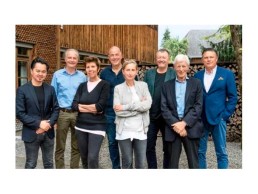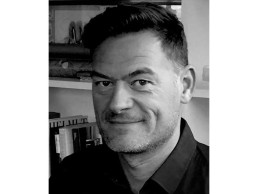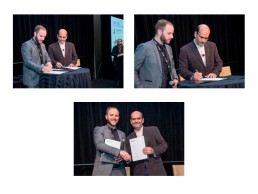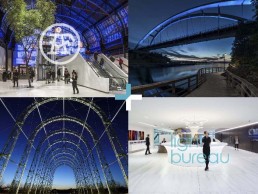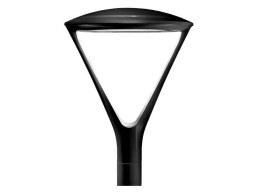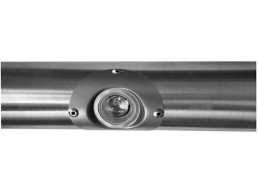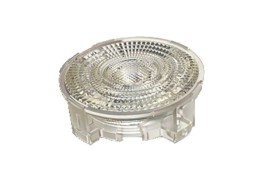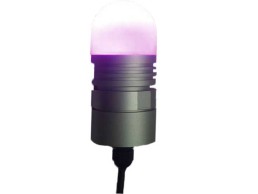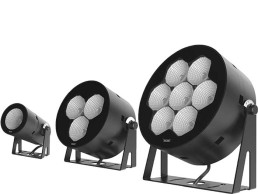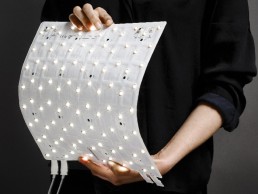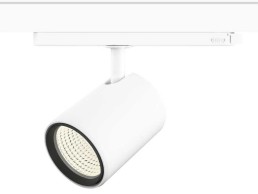Winners announced for Zumtobel Group Award 2017
(Austria) – In what is the fifth edition of the Zumtobel Group Award – Innovations for Sustainability and Humanity in the Built Environment, in 2017 the international expert jury awarded first prizes to the projects submitted by Michael Maltzan Architecture, UNStudio, Arturo Vittori and TeamMinus.
The Zumtobel Group had invited entries in three categories, Buildings, Urban Developments & Initiatives and Applied Innovations. This year there is also a special award for Young Professionals. The international architectural award, curated once again by Aedes Architecture Forum Berlin, honours contemporary realised or conceptual works that make a significant contribution to greater humanity and sustainability in the built environment and its design.
“The Zumtobel Group Award emphasizes the importance of architecture for human beings. Architecture determines how people feel in the built and urban space and how they live there. The Zumtobel Group Award addresses this topic and, just like our lighting solutions, places people in the centre of the living environment,” said Karin Zumtobel, Head of Arts & Culture Zumtobel Group.
A total of 347 projects from 48 countries on five continents were submitted for this year’s award. A first-line jury reviewed the entries and submitted a smaller number to the main jury comprising leading figures from around the world of architecture, as well as experts in the new technologies. The jury then selected five projects per category as nominees and chose a winner from among them in each category.
Along with the three main categories, this year the jury was also tasked with nominating five Young Professionals. Projects qualified for this special award if the persons submitting them were under 40 years of age on 15 January 2017. Here too, the jury chose a winner from among the nominees.
“We have a wide spread of contributions for this prize from all over the world and there is no difference between one country and the other. These are people who are truly dedicated to what they are doing and they do it in such a fabulous, non-egoistic manner, with the aim of trying to create better lives for many other people,” said Jury Chairman Kjetil Trædal Thorsen from Snøhetta Architects.
The first prize in each of the three categories carries a purse of EUR 50,000. An additional purse of EUR 15,000 will be distributed for the Young Professional. This raises the total purse from EUR 150,000 to EUR 165,000.
Award in the Buildings category
First prize in the Buildings category goes to Michael Maltzan Architecture, USA for the Star Apartments project in Los Angeles in which an existing single-floor commercial building was converted into a 95,000 square foot supportive housing facility within Los Angeles’ downtown core. Expanded to six storeys, the building provides 102 homes and support services for previously homeless individuals. “Star Apartments has set a new standard for architecture within the field of social housing, social and environmental sustainability, as well as community and bottom-up processes,” wrote the jury in its statement.
Award in the Urban Developments & Initiatives category
In the Urban Developments and Initiatives category, the award goes to UNStudio, Ben van Berkel and Caroline Bos, in the Netherlands for their master plan for Arnhem Central Station as a new mass transit and mainline rail hub designed for mixed use and to integrate public space. “The impressive and unbending determination of Ben van Berkel and UNStudio to see Arnhem Central Station through a series of significant challenges all the way to completion is exemplary. The project demonstrates the necessity of continuous involvement and engagement for sustainable solutions,” stated the jury.
Award in the Applied Innovations category
First prize in the Applied Innovations category is awarded to Italian architect Arturo Vittori. Vittori impressed the jury with his Warka Water project which provides an alternative water source in the Dorso / Omo Valley region of Ethiopia. The project offers a potential solution to inadequate access to clean and secure water resources in rural regions of Africa. “The strong innovative aspect of the Warka Water project lies in its independent use of archaic knowledge combined with deep understanding of needs and context. To achieve simple and functional solutions for comprehensive problems takes time and intense research,” the jury said.
Special award for Young Professionals
In what is the first edition of this special award for Young Professionals, the winner is Atelier TeamMinus for their Jianamani Visitor Center in Yushu, China. This modern visitor centre in Yushu engages closely with its historical Tibetan context by forging explicit links with the ancient local site intrinsic to Tibetan Buddhism. “The Jianamani Visitor Center awakes hope for the future of architecture, defending the position that experimentation is not contradictory to contextual solutions,” stated the jury.
The jury of the Zumtobel Group Award 2017
The 2017 jury comprised Klaus Daniels, HL-Technik Engineering GmbH; Elke Delugan-Meissl, Delugan Meissl Associated Architects, Elizabeth Diller, Architect Diller Scofidio + Renfro, Elgar Fleisch, Professor of Information Management, Holger Hagge, Architect & Management Expert, Zhang Ke, Architect ZAO/standardarchitecture, Ulrich Schumacher, CEO Zumtobel Group and Kjetil Trædal Thorsen of Snøhetta Architects.
Honourable Mentions
Nominated in the category Buildings and awarded with a honourable mention by the jury are the following projects in alphabetical order: "Farming Kindergarten" by Vo Trong Nghia Architects, Vietnam; "Jianamani Visitor Center" by Atelier TeamMinus, China; "La Maison du Savoir" by Baumschlager Eberle Architekten, Austria and "Transformation of 530 Dwellings" by Anne Lacaton & Jean-Philippe Vassal with Fréderic Druot and Christophe Hutin architects, France.
In Urban Developments & Initiatives, the jury congratulates the following projects on a honourable mention, in alphabetical order: "Empower Shack" by Urban-Think Tank, ETH Zurich, Switzerland; "Recovery of the Irrigation System at the Thermal Orchards" by Cíclica [space·community ecology], Spain; "Sydney Park Water Re-use Project" by Turf Design Studio, Australia and "Urban Rigger" by Kim Loudrup and Bjarke Ingels, Denmark.
In the category Applied Innovations are awarded with a honourable mention, in alphabetical order: "3for2 Beyond Efficiency" by Architecture and Building Systems Research Group, ETH Zurich, Switzerland; "Hy-Fi" by The Living - David Benjamin, USA; "Mine the Scrap" by Certain Measures, Germany and "From Solar Trees to Active Glass Facades" by Opvius GmbH, Germany.
In addition to the awarding of the first prize, the jury spoke out in favour of the following honourable mentions among the Young Professionals, in alphabetical order: "3for2 Beyond Efficiency" by Architecture and Building Systems Research Group, ETH Zurich, Switzerland; "Mine the Scrap" by Certain Measures, Germany; "Nest We Grow – House of Food, for Food" by LIXIL International Student Architectural Competition, Japan, USA and "Salpi Industrial Factory" by Enzo Eusebi + Partners, Italy.
Curated by Aedes
The Zumtobel Group Award 2017 was held under the curatorship of Dr. h.c. Kristin Feireiss and Hans-Jürgen Commerell of Aedes Architecture Forum in Berlin, who have stewarded the architectural award over the past ten years, ever since it was first created.
“In the space of ten years the Zumtobel Group Award has become an established international competition. The Award puts the spotlight on the challenges posed by the design and development of current and future built environments, but that is not all. Because over the years we have continuously adapted the parameters of the Award to the ever-expanding technological possibilities and increasingly digitised processes, enabling the resultant social interactions to be taken into account as the winners are selected,” said the curators Dr. h.c. Kristin Feireiss and Hans-Jürgen Commerell from Aedes Architecture Forum, Berlin.
Douglas James appointed Design Director of Inter-lux
(USA) – Inter-lux appoint Douglas James, award winning lighting and product designer, as their Design Director with immediate effect.
In a move which affirms the company’s commitment and belief in the importance of design throughout their business, US based Inter-lux have made a major appointment to their executive team.
“Aside from being a great Lighting Designer with a clutch of awards to his name, Douglas James is the author of the clearest brand of lighting products on the market today. “Say’s Mark DeVries, CEO of Inter-lux. “Douglas has made Whitegoods into a language. No other brand is as well defined or loyal to its message. It has become the most successful of the European Brands which we represent across North America.”
Inter-lux has had tremendous success in bringing high quality, high design, European manufacturers into the US market, which can be a notoriously difficult process for the uninitiated. Inter-lux has made that process smooth and efficient.
Their current stable includes Whitegoods, Linea Light & iLed, Sattler, Filix, Vice and ALM. They are also currently in the process of bringing Mike Stone and Nimbus to market.
“North America quickly became Whitegoods’ largest market once Inter-lux were involved.” says Douglas James. “Mark and his team have the entire process down. From the UL/ETL certification process and re-interpreting and formatting of literature, through to the market approach via specification, distribution and the best Rep network in the business. They have shown a consistent appreciation and commitment to design since I have known them, so I’m pleased to be in a position to drive that to a new level across the business.”
Design Director is a new position within the organisation, and the remit will cover all aspects of the company’s identity, marketing and product development functions. “When you look at the brands we represent, design is core to all of them. We believe in great design, great products and great service, and that’s exactly what we represent to our customers. Douglas is now a key component of our continually improving capability to deliver just that.” DeVries concludes.
IALD and LUCI sign Friendship Agreement
(USA) - IALD (International Association of Lighting Designers) and LUCI (the international network of cities on urban lighting) agree to work together to promote quality lighting in the urban environment.
The President of the International Association of Lighting Designers (IALD), and the General Director of LUCI, the international network of cities on urban lighting, signed a Friendship Agreement between the two organisations at the IALD Enlighten Americas event in Denver, Colorado.
Signed by Mark Burton-Page, General Director of LUCI and Victor Palacio, IALD, CLD, President of IALD, the Friendship Agreement acknowledges the common goals that unite LUCI and IALD. Both organisations recognise the importance of light and lighting design in the planning and development of urban spaces, and that quality of light is essential to quality of life.
The Friendship Agreement encourages the two organisations to promote cooperative discussion, efforts and activities to raise awareness on the crucial role of light in architectural and urban design. It also constitutes the first step towards initiating a structured dialogue between cities and lighting designers worldwide.
“The Friendship Agreement asserts our intention of exchanging information and increasing collaboration between our two organisations. More cooperation between LUCI and the IALD will foster better projects and developments in cities worldwide.” – Victor Palacio, President of IALD
“Public lighting needs to be a multi-lateral, multi-layered co-construction between cities, industry, researchers and lighting designers. We look forward to strengthening the relationship between LUCI and IALD.” - Mark Burton-Page, General Director of LUCI
IALD Enlighten Americas, Denver, Colorado finished for another year.
(USA) - Another successful annual event for IALD Enlighten Americas, hosted in Denver, Colorado, is over for another year.
From 12-14 October 2017, more than 450 lighting professionals - a record-breaking crowd for the IALD Enlighten conferences - gathered in Denver to learn, connect, and celebrate light.
Over three days, attendees had access to more than 20 educational seminars from some of lighting's leading professionals - view a full schedule of sessions here. Topics included a session on Circadian rhythms presented by Robert Soler from BIOS Lighting; an interactive seminar about negotiation skills presented by Richard Fallon; and a panel presentation from three of HLB Lighting's principals - Carrie Hawley, IALD; Lee Brandt, IALD; and Teal Brogden, IALD - on providing mentoring for the next generation of lighting designers.
This year featured two keynote speakers; opening keynote Roberto Schaefer, ASC/AIC, spoke about his experience as a cinematographer or "writing with light". Closing keynote Rafael Lozano-Hemmer presented a series of his projects in electronic and performance art, exploring the intersections between the experiential, the theoretical, and the political.
A full conference schedule marked this year's event; a walking tour hosted by IALD Rocky Mountain on Wednesday evening welcomed early arrivers to Denver, and additional programming on Thursday - including a hands-on workshop in lighting field measurement provided by Craig Bernecker, PhD - kept attendees busy for all three days.
Light Bureau joins ÅF Lighting
(UK) – London and Oslo-based Light Bureau has joined ÅF Lighting
Light Bureau has become a part of ÅF Lighting, the specialist business area of the ÅF Group.
Established by Paul Traynor in 1999, Light Bureau has gained an enviable reputation in the field of architectural lighting design. Almost two decades on, the practice is still keen to develop, so the opportunity to join a global leader felt like a natural progression.
ÅF’s motivation is to increase its international portfolio and in this respect, Light Bureau is ideally-placed with roughly half its work being non-domestic and half its work UK-based.
Light Bureau was receptive to joining ÅF Lighting, recognising how well aligned the cultures and objectives of both companies are. Light Bureau’s credo is ‘Light as Craft’, which translates into highly individual and meticulously realised projects based on clear strategies. ÅF Lighting define what they do as ‘New Nordic Lighting’, embracing natural simplicity, authenticity and practicality, a mature style which the world recognises as distinctly Scandinavian.
“Light Bureau already has a foot in the Scandinavian market with our Oslo office set up in 2014 with Arve Olsen, so culturally this is very easy to envision,” said Paul Traynor.
“Being part of ÅF Lighting, I foresee access to a richer project base and reinforcement of key skills across infrastructure, daylight and even product design, also a collective understanding and a strategy for training and development. I’m really looking forward to this union and I couldn’t imagine a better fit culturally and professionally.”
“ÅF Lighting and Light Bureau already share a common vision, both rating innovation and professional experience highly. The combination of our teams will provide a solid international platform, from where we will offer lighting design solutions across all sectors. This step further strengthens our brand as a leading lighting design and engineering consultancy,” added Allan Ruberg, Head of ÅF Lighting.
With this move, Light Bureau becomes part of a network of 100 lighting designers in Europe. Paul Traynor will continue as Principal Director for Light Bureau alongside his existing team in London and Oslo.
KIM Lighting, Ouro
The Ouro was designed to blend in naturally with the environment in which it would operate, while meeting strict performance metrics that keep pedestrians safe and secure. The sleek, contemporary style family of luminaires can scale from pedestrian walkways up to 40 feet. It is the first contemporary modern round site/area luminaire to offer up to 37,000 delivered lumens at 137 Lumens per Watt.
Lec-Lyon, 5642-Button A projector
The new 5642-Button A projector offers a discreet handrail LED-integrated solution with lighting performances for passage ways, stairs or terraces. Complying with the Disabilty Discrimination Act (DDA), LEC’s 5642-Button A projector is equipped with an MA4 optic, has a 45-degree horizontal tilt, and is embedded every two meters.
It offers a standard luminous flux of 150 lumens and has a large number of colours. It is IP67-IK10, has with an organic glass scratch-free, UV rays free and has a blasted stainless steel flange grade 316.
Khatod, COSMO
Low profile lenses, 50-70-90mm Ø, made of optical grade PMMA, with very thin lateral profile, for COB LEDs with LES 6-22mm Ø. Each size provides for three beam angles: Narrow, Medium, Wide. Available with holder in PC, transparent and black are available upon request. COSMO lenses allow for standalone mounting by using the mechanical parts of the lighting fixture. All products meet the MR16, PAR30 and AR111 requirements.
The IP Dot, Illumination Physics
Suitable for external use on large buildings, the IP DOTs are very robust and have an IK rating of 10 - the maximum on that scale of impacts, is considered the minimum by Illumination Physics. The integrated LED powered direct view pixel into the façade of a building is said to have paved the way for the creation of visual highlights and media walls. Notably, the connecting feature of all of the DOTs created in the range are all designed for perfect purpose and integration. As no two buildings and situations are ever the same, every DOT product has been different.
Herper, Punto Floodlight
Punto floodlight family utilises Heper’s latest Hybrid technology, a specially designed optical system that combines the multifaceted reflector with an additional lens. The new Hybrid system has many advantages compared to the classical approach resulting with precise control over the light beam, perfect glare control and high efficiency.
Punto Floodlight family has a lumen package starting with 410lm up to 3500lm with CCT options as 3,000K, 4,000K or RGB white.
David Morgan Review: Cooledge TILE Exterior
David Morgan examines the darc awards / architectural winning TILE Exterior, Cooledge’s new offering to illuminate facades, canopies, entrances and large-scale graphics.
Cooledge has worked hard in recent years to promote light as a material. The Vancouver based lighting company has pioneered the development of easy to install, flexible LED light sheet for use in a wide range of back lighting applications. Cooledge Tile Exterior is their latest product and, as the name implies it is their first system that can be used outside in wet locations.
Cooledge started life with a team of engineers from TIR systems and Philips who in 2009 began to develop flexible LED sheets for use in architectural lighting. It is backed by venture capital investors including ARCH Venture Capital Partners and GE Ventures. In 2016 the company was awarded the Deloitte Technology Fast 50T award recognising the company as the second fastest growing technology organisation in Canada.
After various false starts their first product, Cooledge Line, was launched at Lightfair International in 2013 where it was given the Design Excellence Award. I reviewed the Cooledge Square in 2015 and was impressed by the ease of installation with a simple snap together electrical and mechanical connection.
Cooledge have developed the flexibility and ease of installation of their earlier IP20 products and made the Tile Exterior suitable for outdoor lighting applications with an IP65 / wet location rating. There are a number of ingenious design features which make the system work so well.
The 12-inch flexible LED panels can be clipped together with a custom designed IP65 rated snap connector along two sides of the sheet to make up large areas of flat or curved light very much like laying carpet tiles or wood flooring. It is understood that the connectors are rated to be used more than once so that panels can be replaced or re-positioned. The detail construction of the connectors seems quite delicate and they do not appear to incorporate an elastomeric seal which might lead to long term reliability issues.
The system has been fully developed to make life easy for the installer including a series of ingenious wiring looms, complete with push on connectors, that join the power supply to the panels. All exposed connections are capped with snap on covers to ensure that the whole system should be water tight.
A set of holes on 3-inch centres are incorporated in the panels so they can be simply screwed to the mounting surface.
Tile Exterior comes in two levels of light output 300 lumens and 600 lumens per 12-inch square sheet. A variety of colour temperatures are available with a CRI of over 80 and two Macadam ellipse binning.
The Cooledge design approach is to mount a grid of medium power LEDs onto a flexible polymer PCB material with a large surface area of copper and to then run the LEDs at a very low drive current which enables the sheet to work thermally without any additional heat sinking. The LEDs are set on a 1.5-inch pitch and a dot free lit effect can be achieved with a spacing to a standard opal diffuser of around 1.5 to 2-inches.
Efficiency, projected life and rate of lumen depreciation are all better than for traditional light panels using multiple medium power LEDs run at conventional, higher, drive currents. Efficiency levels of around 110 lumens per circuit watt are quoted by Cooledge allowing for power supply losses. Cooledge power supplies are Class 2 rated in North America with a maximum power of 90 watts. This allows up to sixteen standard size panels to be run from one power supply.
Each medium power LED on the tile is encapsulated behind an individual clear moulded window in a design which Cooledge have termed ‘True Temp’. Since no gel encapsulation is used to waterproof the LEDs, the colour temperature of the LEDs is only marginally effected by the clear window material.
The one limitation with the IP65 tiles compared to the IP20 tiles is that the exterior rated version cannot be cut to size without losing their IP65 rating. In order to completely fill the widest range of spaces, the tiles are available in four smaller modular sizes. When used in combination with the standard 12-inch panel almost any size can be tiled based on a 3-inch module.
Tile Exterior has been developed for use in back lighting exterior ceilings, wall panels and light boxes. I asked a number of lighting designers if they had specified or were planning to specify the IP65 version on their projects and there was general agreement that it would be very useful and appears to be well designed for easy installation.
When compared to prismatic side lit LED light sheets there are a couple of issues where the Cooledge system has some drawbacks. An IP67 rating is available for the prismatic sheet compared to IP65 for the Cooledge product and the spacing required to achieve a fully diffuse effect can be much smaller with a side lit panel. The flexibility of the Cooledge Tile Exterior material is of course a big advantage for any non-flat applications and the modular panel sizing should be helpful in minimising project lead times.
Cooledge describe their products as delivering on the promises made for OLED technology, having ‘the potential to fundamentally change the way lighting is integrated into the built environment’. With the new Tile Exterior version that now includes a much larger potential exterior market.
The Cooledge Tile Exterior has already received a good reaction from the lighting design community, winning the best exterior product at the recent darc awards / architectural. The system seems well detailed and is likely to be suitable for use on a wide variety of exterior projects.
David Morgan Associates, a London-based international design consultancy specialising in luminaire design and development and is also MD of Radiant Architectural Lighting.
Email: david@dmadesign.co.uk
Web: www.dmadesign.co.uk
Ansorg, Kono KTM
The surface-mounted spotlight Kono owes its name to the minimal conical housing. Unobtrusive but style-defining details demonstrate functional design. For example, the reflector retaining ring permits fast and easy change of the reflectors and provides very good glare protection. Since this is particularly important in the case of low mounting heights. The integrated driver permits an even more compact design.


